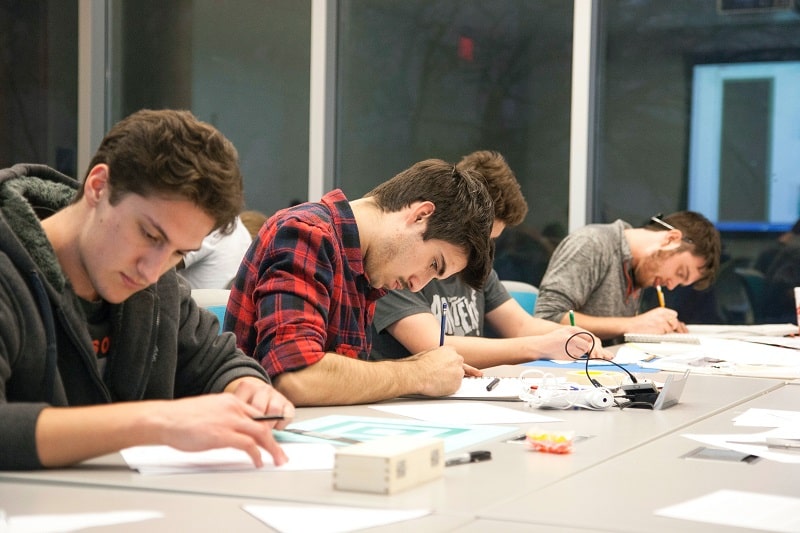
What Is the TASC Test And How to Prepare for It?
Life happens and not everybody is able to get a High School diploma. That in itself is not earth-shattering until you want to enter the workforce or go on to further education.
For that very reason, the TASC test has been developed by the Data Recognition Corporation and the CTB. Passing it can give you the chance to join the career ladder or higher education without having to re-enter high school.
However, when it’s been a while since you sat behind a desk, you may be nervous about the content of the test. What will the test look like? What do you need to study? And how can you ensure that you pass?
So, whether you want to improve your career opportunities or get a college degree, taking the TASC can open the door to opportunities you may currently be missing out on. Here is everything you need to know.
Table of Contents
What Is The TASC Test?
The TASC test is designed to give people who missed out on educational opportunities a chance to obtain a High School Equivalency (HSE) diploma.
The TASC can be completed in either English or Spanish and tests you on five subject areas:
- Reading
- Writing
- Math
- Science
- Social Studies
To get the certification, you have to pass all five sections of the test.
This can be demanding, especially for people who have been out of the education system for some time. But the rewards that come from having this HSE more than compensate for the amount of work involved in doing the test.
The qualification is recognized across 12 states and is highly regarded by a great many employers meaning that it improves your chances of career advancement.
In like fashion, it is seen as an indication that the person with the certification is ready for college.
What Is The Format Of The Tests?
Each of the tests follows its own distinct format:
Reading
The reading test assesses your reading skills and shows if you are ready for a career or college education.
The test is difficult because it assesses how you measure up to the Common Core’s reading standard at this level. You will be asked to work with informational texts for 70% of the exam and literary texts for the remaining 30%of the exam.
For the non-reader, the types of texts given can be challenging. The pieces you will have to read can include stories, drama, poems, myths, and non-fiction.
Four essential principles will be tested for each text given:
- Comprehension. Do you understand the text?
- Analysis. Can you analyze details within the text and explain them
- Application. Can you take ideas and themes from one text and use them in a different context?
- Synthesis. Do you understand the ideas that major themes and images within a text convey?
Essentially you are being tested on your ability to grasp key ideas and details within a piece. You are also being tested on how well you understand how a piece is structured and if you understand the imagery and figurative language used in the piece.
Example Question:
Look at the following question from a sample reading test. On the real exam, you can expect a longer piece with several questions.
This particular question tests your understanding of what the writer is conveying when using a quotation from another source.
Read this paragraph from the text.
Law Professor Eric Posner contends that online shaming occurs without due process. People broadcast their gut reactions to the whole world harshly and often disproportionately. All the while, author Jon Ronson claims, we do not feel responsible for the destruction since “a snowflake doesn’t need to feel responsible for an avalanche.”
The author uses Ronson’s quote, “a snowflake doesn’t need to feel responsible for an avalanche,” to convey the message that:
- Shamers’ legal accountability for the destruction of the target’s life is limited.
- Though shamers believe they are not responsible for the destruction, they are.
- Shamers are not responsible at all for the destruction as they do not act alone.
- Shamers are only partially responsible for the harm as they help deliver justice.
The correct answer is (2).
To get a headstart on your preparation, read the piece again and try to get an idea of why the other answers are not the correct ones.
For example, answer 4 says that shamers “Help deliver justice.” However, there is no reference to justice in the paragraph.
Coming up with the correct answer in the test means that you will have to skim the piece and eliminate what is an incorrect answer in your search for the correct one.
However, if you practice with sample papers, you will get to the stage where you will be able to identify the correct answer quickly.
Writing
In the writing test, you must show examiners you have reached the standard expected from grade 7-12 students.
All answers are scored under the following four headings:
- Mechanics. Can you use capitalization, punctuation, and correct spelling?
- Usage. How good is your grammar? Do you use words correctly?
- Organization. Can you organize ideas clearly and logically? How correctly do you use sentences and paragraphs?
- Sentence Structure. Can you identify run on sentences, unfinished sentences or poorly structured sentences?
Example question:
Can you find the misspelled word in the following sentence?
She said she could not concieve of leading such an eventful life, yet she promised to come watch his new ballet performance at the local theater.
Bear in mind the spelling rule “I before E except after C.” when doing this one!
Maths
Your mathematical reasoning skills will be tested in this subtest. You can expect questions involving word problems, algebra, and geometry.
The test comes in two sections.
In the first section, you have to do 40 multiple choice questions with 12 gridded response questions in the second section. You are allowed to use a calculator in the second section but not in the first.
The English version of the test is 105 minutes, and the Spanish version is 125 minutes.
Example question:
You can expect questions along the following lines.
What is the solution to the following equation?
The correct answer is (3).
Areas you need to prepare for in the Math test include:
- Statistics and Probability
- Geometry
- Functions
- Algebra
- Numbers and Quantities
Science
You will be tested on:
- Earth Sciences
- Life Sciences
- Space Sciences
Next Generation Science Standards will be used.
Marks are divided virtually equally between the three sciences meaning that you need to devote your preparation time equally to each of the three areas.
Example question:
What do proteins and DNA have in common?
Both are translated from RNA.
Both are composed of building blocks.
Both reflect the full sequence of a gene.
Both are catalytic molecules.
The correct answer is (2).
Social Studies
Social Studies covers a wide range of topics, with each section accounting for a percentage of the marks as follows:
- US History 25%
- World History 15%
- Civics and Government 25,%
- Geography15%
- Economics 20%
Example question:
You can expect questions along the following lines.
Read the following list and answer the question that follows.
- Hot, humid climate
- High precipitation
- Dense tropical rainforests
- A rich diversity of animal and plant life
Which geographic region is described by the list?
- Sahara Desert
- North America
- Southern Africa
- Amazon River Basin
The correct answer is (4).
If caught for preparation time here, devote most of your time to the areas allocated the highest percentage of marks.
How Do I Prepare For The TASC?
Preparing for any examination means:
- Finding out all you can about the format of the exam.
- Becoming familiar with the style of questioning
- Practicing on test papers
In a school situation, the teachers will give you all the information you need for the above but being in a non-school situation means having to source the information yourself.
Rather than conducting time-consuming online searches, your best course of action is to contact an agency that helps students with their academic exams.
For this, we recommend TestPrep-Online, which has 30 years of experience in helping students prepare for exams.
They have tailored materials and practice TASC tests that are the closest you can get to the real exam. Using their services, you will get a test prep pack containing:
- All the information you need about the exam
- Sample papers modeled on the real tests for you to practice on
- A scoring system to check your results as you do the sample tests
- Helpful study guides
For extra practice, check out these free sample verbal reasoning questions.
Is The TASC Hard?
It is challenging, firstly because you have to pass all five subtests.
Secondly, passing the TASC is considered the equivalent of matching the abilities and performances of the top 40% of high school diploma holders.
That in itself is no mean achievement.
But there are factors that can make it more doable, the chief one being that if you fail a subtest, you can take it again without having to redo the subtests you have passed.
However, the main challenge for people who have been out of school for some time is getting back into the routine of studying and doing academic exercises.
You will have to do the preparation on your own without having school and teachers to rely on.
If you are already working a job, fitting that extra work into your routine will be demanding, but it can be done and done very successfully.
Study Tips
The above information shows you just how challenging the TASC tests are. You may even be wondering how you can prepare for this, especially if you are working a job.
However, keep the rewards to be gained from succeeding at the test at the forefront of your mind while you set about taking on the challenge.
Knowing that it’s going to be worth it is the greatest motivator of all!
Then take an organized approach to your preparation:
- Begin preparing as soon as you possibly can. You have a lot of material to get through, and last-minute cramming will damage your exam performance.
- Work to a timetable. We all have wasted time in our schedules. Find those “doing nothing” times and use them for your preparation.
- Use your brain in the best way possible by adopting good study techniques. Work in short blocks of time, 50-minute blocks are ideal. Follow a study block with a 10-minute break, then rinse and repeat. Working in long unbroken blocks is counterproductive as we do not retain material when working like that.
- Take brief notes as you work. These will prove useful when it comes to revising. We learn more quickly if we write or do questions when studying, and it also helps us avoid that experience of having words flitter past our eyes.
- Build in 30 or so minutes of revision time at the end of a day’s study. Use the notes you have taken for this. Don’t forget to do some revision also at the weekends.
Use Your Sample Papers
Doing sample questions is the best preparation of all for an exam. You have studied the material, but by doing questions, you are applying the material to the exam.
Making the sample papers an essential part of your preparation ensures:
- You are focusing on the exam at all times
- You are becoming increasingly familiar with the format and style of questioning in the exam
- You are adjusting to the time limitations of the tests
- You can monitor your progress by checking your scores after each test you do.
- You quickly identify areas you are having difficulty with. Make sure you devote more time to them.
- Take care of your physical well-being. Your brain will work better if you get plenty of sleep, fresh air, and good nutrition.
Doing The Tests
Approach the tests well rested and clear-headed. Avoid the temptation to do all-night cramming marathons in the lead-up to the tests. Your performance in the exams is what matters now.
If you become nervous before doing tests, and most of us do, have some stress-busting exercises you can fall back on. Yoga, deep breathing, and stretching all work, or you may have your own techniques.
And finally, go in there, do the best you can. You have worked for this and deserve it!
If you are planning on doing the TASC test, you will find all the resources you need here.
Written by Elizabeth O Mahony
With 25+ years’ experience as a teacher and state examinations corrector, Elizabeth now writes for the education and careers industry. Her experience preparing students for examinations and running an academy for supplementary education give her invaluable insights into what it takes for job seekers and graduates to succeed in assessments.
Sarah is an accomplished educator, researcher and author in the field of testing and assessment. She has worked with various educational institutions and organisations to develop innovative evaluation methods and enhance student learning. Sarah has published numerous articles and books on assessment and learning. Her passion for promoting equity and fairness in the education system fuels her commitment to sharing insights and best practices with educators and policymakers around the world.









